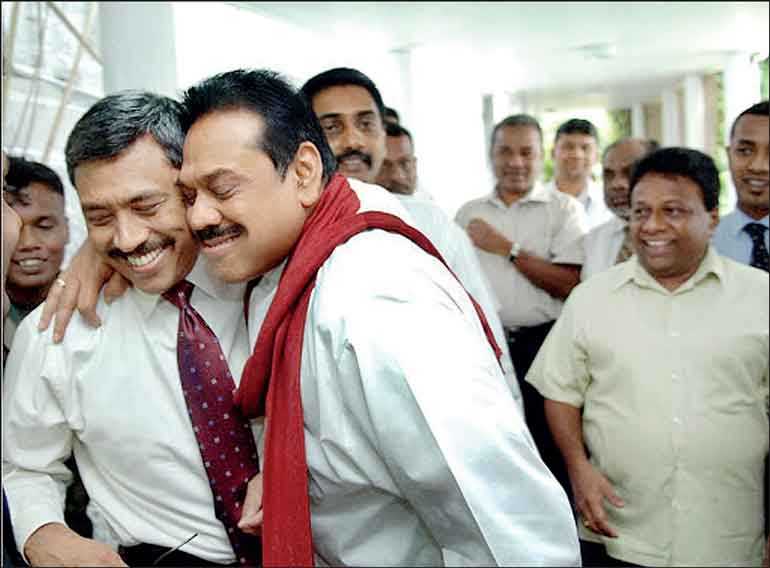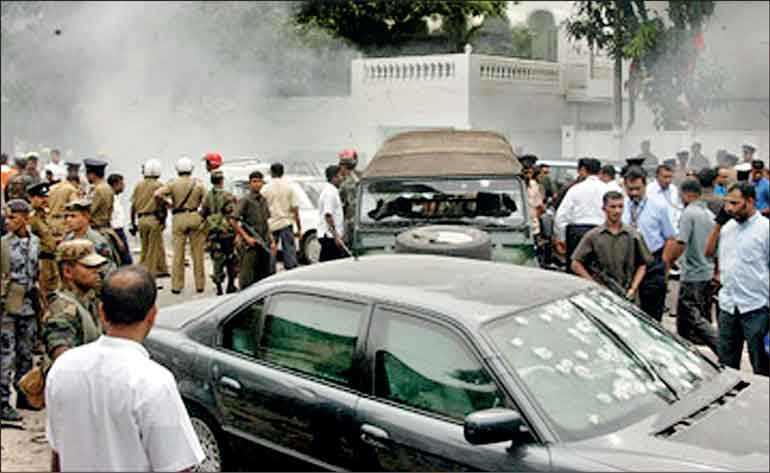Thursday Dec 04, 2025
Thursday Dec 04, 2025
Wednesday, 18 November 2020 00:10 - - {{hitsCtrl.values.hits}}

The proverbial saying about blood being thicker than water was very much evident as “Mahinda Aiya” embraced “Gota Malli” tightly and hugged him speechlessly for more than a minute when Gotabaya arrived safe and sound at Temple Trees

Four people including the suicide bomber were killed in the incident and 17 vehicles including two passenger buses were damaged in the attack
Nandasena Gotabaya Rajapaksa won the Presidential Elections on 16 November 2019. He was formally sworn in as President two days later at the Ruwanweliseya in Anuradhapura. Today 18  November is the first anniversary of President Gotabaya Rajapaksa assuming office. Incidentally the President’s elder brother, former President and current Prime Minister Mahinda Percy Rajapaksa will also be celebrating his 75th birthday today (18).
November is the first anniversary of President Gotabaya Rajapaksa assuming office. Incidentally the President’s elder brother, former President and current Prime Minister Mahinda Percy Rajapaksa will also be celebrating his 75th birthday today (18).
While extending wishes to the two Rajapaksa brothers on their respective mile-post anniversaries, this column focuses this week on another important anniversary in the life of President Gotabaya Rajapaksa 14 years ago. It was on 1 December 2006 that the Liberation Tigers of Tamil Eelam (LTTE) made an attempt in Colombo to assassinate Gotabaya Rajapaksa serving as Secretary of Defence under his brother and then President Mahinda Rajapaksa. Gotabaya miraculously escaped that attempt and went on to forge his inevitable tryst with destiny.
‘Piththala Handhiya’
The abortive attempt was made in a picturesque area of Colombo along the Anagarika Dharmapala Mawatte formerly known as Turret Road. It happened in close proximity to the intersection with Sir James Peiris Mawatha earlier known as General’s Lake Road. The junction had acquired the name ‘Piththala Handhiya’ or Brass Junction. In fact the attempt on Gota’s life was described in the media as the Piththala Handhiya attack.
The name Piththala Handhiya had come into vogue due to a family selling brassware on the road near the junction by displaying their merchandise on a grassy patch. The artisan family comprising two young sons and their parents hailed from Pilimatalawa in Kandy. They started this wayside exhibition cum sale in the late seventies of the previous century. The brassware they sold were elegantly handcrafted lamps, trays, plates and goblets. Many people including myself would tarry at the spot for a while, chat to the vendors and take a close look at the exquisite brassware – an aesthetic delight!
To digress slightly, when I returned to the land of my birth in 2013 after a 25-year-long absence, one of the places I visited was this Piththala Handhiya area. Sadly I did not see these brassware sellers there. The quaintly colourful landscape dotted with colonial-type houses and flowery gardens had given way to crass commercialisation in the name of progressive development.
When I made inquiries I was told by some flower sellers in the vicinity that the parents were no more and that the sons – now with families of their own – had gone to Italy. Shortly before writing this article, I made efforts through a friend in Colombo to ascertain whether the brass sellers were at Piththala Handhiya or not. It was confirmed that they had not been sighted for many years. However the name “Piththala Handhiya” still lingers.
It is against this backdrop that I re-visit the Piththala Handhiya attack. Mahinda Rajapaksa had been elected President in November 2005 and hostilities with the LTTE had begun to escalate. A triumvirate comprising President Mahinda Rajapaksa, Defence Secretary Gotabaya Rajapaksa and Army Commander Sarath Fonseka provided political, administrative and military leadership respectively in prosecuting the war against the LTTE.
The Piththala Handhiya attack
Tiger Intelligence Chief Pottu Ammaan began targeting Mahinda, Gota and Sarath for obvious reasons. The LTTE drew first blood when a woman suicide bomber infiltrated the Military Headquarters in Colombo and exploded herself in a bid to kill Sarath Fonseka. Though seriously injured the tough Army Commander survived the attack that took place in April 2006. Fonseka was however out of action for some months while making a remarkable physical recovery from injuries sustained in the attack.
Despite Fonseka’s absence the then Defence Secretary filled the void by rising to the occasion. The experience he had had as a soldier in Sri Lanka as well as the influence he enjoyed as the President’s sibling helped Gota Rajapaksa carry out his duties efficiently. It was widely acknowledged then that the defence secretary was planning, coordinating and overseeing the on-going war effort against the Tigers.This energised the LTTE into expediting efforts to eliminate Gotabaya. Several plots were hatched.
Finally one of the assassination plans was executed on Friday 1 December 2006. The LTTE had done its ‘rekke’ or reconnaissance and found a pattern in the Defence Secretary’s movements. He used to take one of two routes alternately when he set out to work from his official residence in the mornings. Whenever he set out from home, officers in charge of Gotabaya’s security would station themselves at key junctions along the route. Traffic would be stopped in advance for Gota’s motorcade to proceed smoothly along the road without hindrance or delay.
These arrangements by themselves provided an early inkling to anyone observing traffic movements that a VVIP was soon going to motor down the road. A far more serious flaw in this practice was that of traffic being allowed on the other side of the road. While traffic was stopped on one side of the road, vehicles were allowed to proceed in the opposite direction on the other side of the road.
The LTTE exploited this loophole and put its action plan into practice on 1 December 2006. A bomb weighing 25 kilos was fitted on to a trishaw. Anticipating that the Defence Secretary was going to proceed along the route in question, the ‘Black Tiger’ suicide assassin of the LTTE positioned his explosive laden three-wheeler on the opposite side of the road that Gota was to travel along.
Gotabaya Rajapaksa was on his way to ‘Temple Trees’ for the National Security Council meeting that morning. Gota’s nine-vehicle motorcade proceeded along Anagarika Dharmapala Mawatta towards Galle Road. The convoy had to cross Sir James Peiris Mawatha at ‘Piththala Handhiya’. The traffic was stopped by Special Forces personnel in charge of Rajapaksa’s security for the motorcade to pass when a red three-wheeler bearing the number WP – GH 0617 cut in from the other side and tried to ram into the motorcade. However the three-wheeler driver found it difficult to get close to the motorcade because of the heavy traffic on his side.
The assassin somehow manoeuvred the three-wheeler and moved in close. The escort Defender Jeep in front of Rajapaksa’s bullet-proof BMW vehicle collided with the three-wheeler and an explosion occurred at 10:39 a.m. It is not clear as to whether the explosion was triggered off by the impact of the collision or whether the assassin detonated the bomb deliberately.
The explosion hit the Special Force outrider riding alongside Rajapaksa’s vehicle. Both the motorcyclist and the Jeep driver were killed along with the suicide bomber in the explosion. The Defender Jeep and motorcycle bearing the brunt of the explosion was a godsend to Gotabaya’s BMW vehicle as that minimised the full force of the blast.
The bonnet, headlights, tyres and windscreen Gotabaya’s vehicle were damaged in the explosion. The driver too sustained minor injuries. But both Rajapaksa and his personal bodyguard seated in the front seat were unhurt. Rajapaksa seated in the left side backseat was thrown to the right side due to the explosion. He was apparently dazed and lay still on the back seat. Some glass splinters had grazed him slightly. His right eyebrow was cut – a few drops of blood were seen on his shirtsleeves and collar.
Even as his vehicle screeched to a halt, the dazed Gota asked, “What happened?” in Sinhala. The Defence Secretary’s Personal Security Officer H.D. Kapuhena replied, “We are under attack,” and jumped over the seat to the rear. Kapuhena put his body armour over Rajapaksa’s torso and a gas mask over his head. The explosion had caused the vehicle doors to jam and Kapuhena began shouting out to other security men in the convoy to open the doors of the BMW.
A crowbar was brought and the doors broken open. Kapuhena put Gota into another Defender Jeep that sped off towards Galle Road and thereafter to Temple Trees. Kapuhena and other security personnel fired shots rapidly in the air as the vehicle proceeded to clear the way. It terrified ordinary people in Colpetty who thought a gun battle was on between the security forces and some Tigers in Colombo. Several parents rushed to schools and took their children home.
Mahinda and Gotabaya
Meanwhile President Mahinda Rajapaksa had been at an official discussion at Temple Trees when he heard reports of an explosion. He had immediately rushed out of the room saying, “This is the time Gota is expected to be here. See what has happened.”
When reports of an attack on Gotabaya’s convoy reached Mahinda, he became frantic and was seen and heard shouting agitatedly on the telephone. When Mahinda Rajapaksa was informed that Gotabaya was safe he urged the security personnel to bring his brother to Temple Trees immediately.
Mahinda was reportedly overjoyed when Gotabaya arrived safe and sound at Temple Trees. The proverbial saying about blood being thicker than water was very much evident as “Mahinda Aiya” embraced “Gota Malli” tightly and hugged him speechlessly for more than a minute. Those who saw the scene were touched at the sight of Mahinda’s moist eyes. Gotabaya was smiling with relief as his brother clasped and kissed him. Mahinda recovered later to exclaim, “They can’t kill you! You can’t be killed!” in Sinhala.
Gotabaya’s wife Anoma Rajapaksa was at a Seva Vanitha meeting being held at the Sri Lanka Air Force Headquarters when the incident took place. After being informed about the attack, Anoma rushed to Temple Trees and was greatly relieved to see her husband safe and unhurt.
“God saved me,” Gota told ‘The Island’ newspaper. “My bodyguards broke open the door and helped me out,” he said, adding, “Commandos reacted swiftly as they observed the vehicle coming towards the convoy.”
Gotabaya then went to a hospital for a check-up. Thereafter he went home to rest and recuperate. Before going home and taking rest, Gotabaya issued a statement addressing the nation from Temple Trees itself. In that Gotabaya stated: “You may already be aware that through the blessings of good fortune, the LTTE terrorists failed in their attempt to take my life today. I take this opportunity to inform you that I am not ready to abandon the responsibility we have towards the country in the face of such cowardly attacks by the LTTE, and to reaffirm our commitment to the national need to defeat LTTE terrorism…”
Dead, injured, and damages
Meanwhile in the aftermath of the abortive attack, security officers had cordoned off the area of explosion and stopped traffic till late into the night. Firefighters were called in to douse the flames engulfing some vehicles after the explosion. Seventeen vehicles including two passenger buses were damaged. Eight of these were extensively damaged. The vehicles belonged to both security forces and civilians.
Four people including the suicide bomber were killed in the incident. Two security officers and a civilian pedestrian were also killed. The security personnel killed were a motorcycle rider travelling alongside Gotabaya’s BMW vehicle. The other was the driver of the Defender Jeep in front of the Rajapaksa vehicle.
The motorcyclist riding alongside Gotabaya’s vehicle was Lance Corporal PHP Wijerathne of the Sri Lanka Army service Corps. He was from Arawwala, Mawattegama in Kurunegala District. The driver of the escort Defender Jeep travelling in front of Rajapaksa’s vehicle killed was Lance Corporal N.K. Piyasiri of the Gajaba Regiment. He was a native of Warakkendeniya, Neluwa in the Galle District.
Eighteen persons were injured in the incident. Of these 13 were admitted to hospital. Eight were security men while five were civilians. Three of the injured were admitted to the Nawaloka Hospital and the others to Colombo National Hospital.
Among injured civilians were the then Foreign Ministry Secretary H.M.G.S. Palihakkara and former Treasury Secretary Charitha Ratwatte. The injuries sustained by both were of a minor nature. Both Palihakkara and Ratwatte were travelling separately at that time and were not part of Gotabaya’s motorcade.
The statements of more than 20 eyewitnesses were also recorded. A 27-year-old bus driver I.S. Weerasekera, who worked on the 112 Kotahena-Maharagama route, said his bus had been stopped at the traffic lights by the Special Forces to make way for the Defence Secretary’s convoy when he suddenly heard a big bang and saw flames. “Suddenly I heard a huge blast and soon after saw clouds of smoke followed by blazes rising from under the mango tree. Then a bike in flames came hurling towards the bus. I ducked to avoid being hit, and the windscreen was shattered,” he added.
The suicide bomber
The severed head of the suicide killer was found in the back of a double cab about 25 metres away from the explosion. Police also said that the mobile phone of the suicide bomber was in police custody. It was also reported that the police had taken into custody around 15 Tamils in Colombo for questioning.
Police also announced then that the registered owner of the three-wheeler had been traced. The owner was Anthony Bernard Christopher of Kadawatte. When further inquiries were conducted it was discovered that the three-wheeler had been recently sold for Rs. 300,000 to a man known as Mohammed Latheef Mohammed Fareed who was staying in Modera. It was found that three months’ rent in advance and ‘key money’ amounting to Rs. 200,000 had been paid by Fareed to the landlord for the Modera residence.
As investigations progressed it was discovered that M.L.M. Fareed though bearing a Muslim name and identity card was actually a Tamil named Balasingham Vijayakumar. He was a ‘Karumpuli’ or Black Tiger assigned the task of blowing up an explosive laden vehicle and killing Gotabaya Rajapaksa. The three-wheeler driver who blew up his explosive-laden vehicle and died in the process was none other than Balasingham Vijayakumar alias Mohammed Latheef Mohamed Fareed.
Subsequent probes also uncovered that the 25 kilo bomb used in the attack had been transported by the LTTE in a vehicle belonging to the reputed international humanitarian organisation CARE (Cooperative for Assistance and Relief Everywhere). The driver of the CARE double-cab was Thambirajah Yogarajah, an LTTE intelligence operative working as a driver for CARE. The bomb had been concealed in the fuel tank of the vehicle. It was removed from the CARE vehicle at Wellawatte and then brought to Modera where it was fitted on to the three-wheeler.
‘Mastermind’ Morris
Even as investigations continued it became crystal clear that the LTTE had set up an intricate network in Colombo and other key areas of the south to conduct attacks and assassinations. After relentless search, the ‘Mastermind’ directing LTTE operations in the South was apprehended in August 2009, three months after the LTTE was militarily defeated in May 2009.
The mastermind directing LTTE operations in the South then was Selvaraja Kirupakaran alias Morris. Just as the LTTE three-wheeler assassin targeting Gota pretended to be a Muslim in Colombo, Kirubakaran alias Morris too lived in Colombo pretending to be a Muslim named Mohammed Nisthar. He had two residences – one in Kuppiyawatte and another in Dematagoda. After scrutinising the movements of Morris for a while the Police TID closed in on the Tiger operative when he was travelling on his scooter from Dematagoda towards Maradana. “Morris” swallowed cyanide capsules when he fell after his scooter collided with a police jeep.
Police rushed Kirupakaran alias Morris to the National Hospital where he was treated and pronounced out of danger after two days. Consequently Morris was interrogated intensively. He reportedly provided much information about LTTE attacks in the south and admitted to being the mastermind bearing overall responsibility for executing them. Much of the information gleaned from Morris is now of academic interest as the LTTE was defeated conclusively in May 2009. Morris continues to be in custody still.
Gotabaya Rajapaksa who miraculously escaped the attempt on his life in 2006 went on to play a constructive role in winning the war – dubbed as Gota’s war – against the LTTE. As is well-known Gota won the Presidential Polls last year decisively and assumed office as President. The executive presidency was empowered further by the passage of the 20th Constitutional Amendment this October.
The first anniversary of the Gotabaya Rajapaksa presidency will be marked by an address to the nation by President Rajapaksa today, 18 November.
(D.B.S. Jeyaraj can be reached at [email protected])